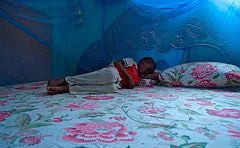
- Data from Rapid Diagnostic Tests shows that malaria prevalence in children aged 6 months to 5 years fell by half from 18 per cent in 2007/08 to 9 per cent in 2011/12.
- Reported malaria deaths declined from around 20,000 per year in 2004-06 to below 12,000 in 2011. While there is a possibility that the malaria deaths are underreported, the trend signals substantial improvement.
Tanzania’s recent success in reducing malaria-related morbidity and mortality can be linked to a significant scale up of interventions aimed at preventing transmission of the malaria parasite, controlling mosquito populations, and improving treatment:
- In 2011/12, 78 per cent of children under the age of five slept under a mosquito net, a more than two-fold increase from 2007/08 (36 per cent). Most nets were distributed through public health campaigns in 2009-11 and were funded by development partners.
- There was a significant increase in households that had been sprayed with insecticides over a 12-month period, from four per cent in 2007/08 to 14 per cent in 2011/12. Most indoor residual spraying was undertaken around Lake Victoria and in Zanzibar.
Nevertheless, there has been less progress in increasing timely access to antimalarial medications for expectant mothers and young children – the two groups particularly vulnerable to the disease:
- In 2011/12, only 33 per cent of women who had previously given birth had received the recommended 2+ doses of SP/Fansidar during pregnancy, marginally up from 31 per cent in 2007/08.
- In 2011/12, the proportion of under-fives with fever who started their treatment on the same or next day following the onset of fever stood at only about 60 per cent (amongst those who medicate), a negligible improvement from 2007/08. Since malaria can rapidly progress to severe levels, the delay in treatment for the remaining 40 per cent partly explains why malaria continues to be a leading cause of death amongst young children.
It is striking that many cases of fever are treated presumptively for malaria without confirmatory tests. In 2011/12, just 25 per cent of under–fives with fever had any blood sample taken for testing. This tendency not only contributes to the delayed diagnosis of non-malarial diseases, protracted illness and unnecessary side-effects, but it also raises public and private healthcare costs and increases the risk of drug resistance.
All of this raises the following questions:
- What could explain the fact that many children receive delayed treatment for malaria? Could it be the lack of access to health facilities? Insufficient knowledge about malaria? High cost of drugs?
- How can malaria diagnosis be improved? Through better laboratory facilities? Greater use of Rapid Diagnostic Tests (RDTs)? Better training of healthcare personnel?
- Why are few pregnant women receiving the recommended doses of preventive malaria treatment?
- What can be done to maintain the current high coverage of mosquito nets given that nets typically last 3-5 years and the last distribution campaign ended about two years ago?
Note: Data are from the WHO’s World Malaria Report 2012 and the 2007/08 and 2011/12 Tanzania HIV/Aids and Malaria Indicator Surveys (THMIS). All are publicly available.
*The 2007/08 and 2011/12 THMIS used slightly different malaria tests, which could have an impact on reported malaria prevalence amongst children.




Join the Conversation